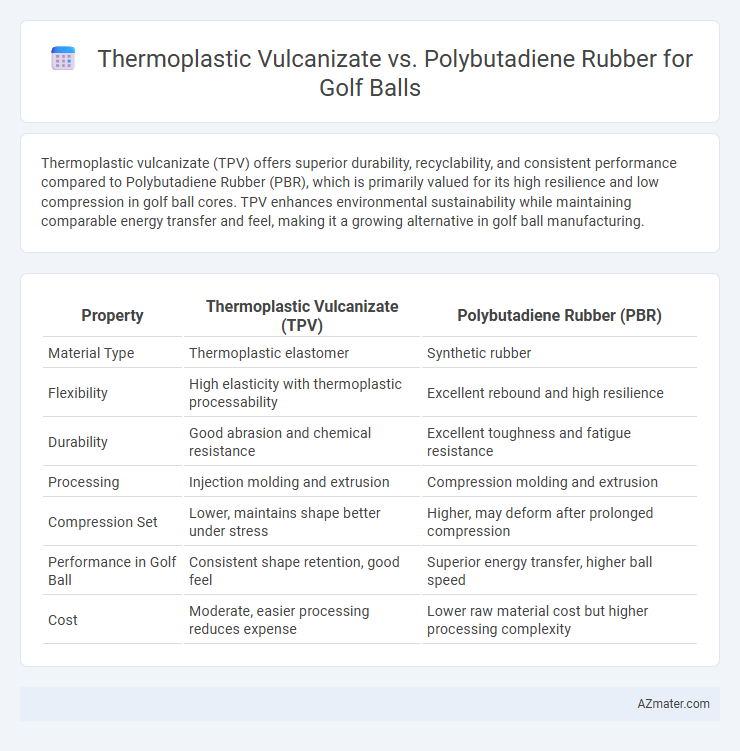Thermoplastic vulcanizate (TPV) offers superior durability, recyclability, and consistent performance compared to Polybutadiene Rubber (PBR), which is primarily valued for its high resilience and low compression in golf ball cores. TPV enhances environmental sustainability while maintaining comparable energy transfer and feel, making it a growing alternative in golf ball manufacturing.
Table of Comparison
| Property | Thermoplastic Vulcanizate (TPV) | Polybutadiene Rubber (PBR) |
|---|---|---|
| Material Type | Thermoplastic elastomer | Synthetic rubber |
| Flexibility | High elasticity with thermoplastic processability | Excellent rebound and high resilience |
| Durability | Good abrasion and chemical resistance | Excellent toughness and fatigue resistance |
| Processing | Injection molding and extrusion | Compression molding and extrusion |
| Compression Set | Lower, maintains shape better under stress | Higher, may deform after prolonged compression |
| Performance in Golf Ball | Consistent shape retention, good feel | Superior energy transfer, higher ball speed |
| Cost | Moderate, easier processing reduces expense | Lower raw material cost but higher processing complexity |
Introduction to Golf Ball Materials
Thermoplastic vulcanizate (TPV) offers enhanced durability and resilience compared to traditional polybutadiene rubber in golf ball construction. TPV materials provide superior resistance to abrasion and deformation, improving overall ball longevity and performance consistency. Polybutadiene rubber remains favored for its high energy return and soft feel, essential for driving distance and control in premium golf balls.
Overview of Thermoplastic Vulcanizate (TPV)
Thermoplastic Vulcanizate (TPV) is a highly versatile material combining the elasticity of vulcanized rubber with the processability of thermoplastics, making it suitable for golf ball covers requiring durability and resilience. TPV offers superior abrasion resistance, weatherability, and consistent performance in varying temperatures compared to Polybutadiene Rubber, which is primarily chosen for its exceptional energy return and low compression. The blend of polyolefins and cross-linked rubber phases in TPV enables enhanced manufacturing efficiency and recyclability without compromising the mechanical properties essential for high-performance golf balls.
Overview of Polybutadiene Rubber (PBR)
Polybutadiene Rubber (PBR) is a synthetic elastomer known for its exceptional resilience, high wear resistance, and low heat build-up, making it ideal for golf ball cores to enhance distance and durability. Its molecular structure provides excellent energy return and superior impact absorption, which improves ball speed and control. In comparison to Thermoplastic Vulcanizate (TPV), PBR offers greater elasticity and consistent performance under various playing conditions.
Material Properties Comparison: TPV vs PBR
Thermoplastic vulcanizate (TPV) offers enhanced flexibility, superior abrasion resistance, and better thermal stability compared to polybutadiene rubber (PBR), making TPV an ideal choice for consistent performance in golf ball covers. PBR provides excellent resilience and low compression, contributing to higher ball speed and distance but tends to exhibit lower durability and weather resistance than TPV. The superior processing ease and recyclability of TPV also make it a more sustainable alternative in golf ball manufacturing compared to the traditional elastomeric properties of PBR.
Impact on Golf Ball Performance
Thermoplastic vulcanizate (TPV) provides superior resilience and energy return in golf balls, enhancing distance and durability compared to polybutadiene rubber, which, while offering excellent compression and feel, tends to have lower recovery rates. TPV's improved elastic properties contribute to consistent ball speed and longer flight, critical for players seeking distance without sacrificing control. In contrast, polybutadiene's impact absorption allows for softer feel but may reduce overall ball speed and distance due to higher energy loss during impact.
Durability and Weather Resistance
Thermoplastic vulcanizate (TPV) offers superior durability and excellent weather resistance compared to polybutadiene rubber, making it ideal for golf ball covers exposed to frequent impact and harsh outdoor conditions. TPV maintains its elasticity and resists UV radiation, ozone, and moisture degradation better than polybutadiene, which tends to wear down and crack over time. The enhanced resilience of TPV ensures longer-lasting performance and consistent ball spin and distance, even after extended play in variable weather.
Processing and Manufacturing Differences
Thermoplastic vulcanizate (TPV) offers superior processing advantages over polybutadiene rubber (BR) in golf ball manufacturing due to its melt-processability, enabling injection molding and shorter cycle times. TPV's ability to be re-melted and reprocessed reduces waste and simplifies part consistency compared to BR, which requires complex vulcanization and longer curing times. These differences lead to more efficient mass production and improved dimensional control in TPV-based golf balls versus traditional BR cores or covers.
Cost-Effectiveness Analysis
Thermoplastic vulcanizate (TPV) offers superior cost-effectiveness over polybutadiene rubber in golf ball manufacturing due to its recyclability and lower processing time, reducing overall production expenses. Polybutadiene rubber, while providing excellent resilience and performance, involves higher material and curing costs that increase the final product price. Manufacturers seeking to balance performance with budget constraints often prefer TPV for its durability and economic advantages in mass production.
Environmental Impact and Sustainability
Thermoplastic vulcanizates (TPVs) offer enhanced recyclability compared to polybutadiene rubber, enabling golf balls made from TPVs to be more easily reprocessed and reducing landfill waste. Polybutadiene rubber, a synthetic elastomer derived from petroleum, has a higher carbon footprint due to energy-intensive production and limited end-of-life options. Selecting TPVs for golf ball manufacturing supports sustainability goals by lowering environmental impact through improved material recovery and reduced reliance on non-renewable resources.
Choosing the Right Material for Golf Balls
Thermoplastic vulcanizate (TPV) offers superior durability and consistent performance in golf ball covers due to its high abrasion resistance and excellent resilience compared to polybutadiene rubber (BR), which provides greater elasticity and enhanced energy transfer for increased ball speed and distance. Selecting TPV enhances overall ball longevity and control, suitable for players prioritizing durability and shot precision, while polybutadiene rubber is preferable for those aiming for maximum distance and a softer feel. Golf ball manufacturers must balance these material properties with player preferences to optimize performance characteristics such as spin rate, hardness, and compression.

Infographic: Thermoplastic vulcanizate vs Polybutadiene Rubber for Golf Ball
 azmater.com
azmater.com